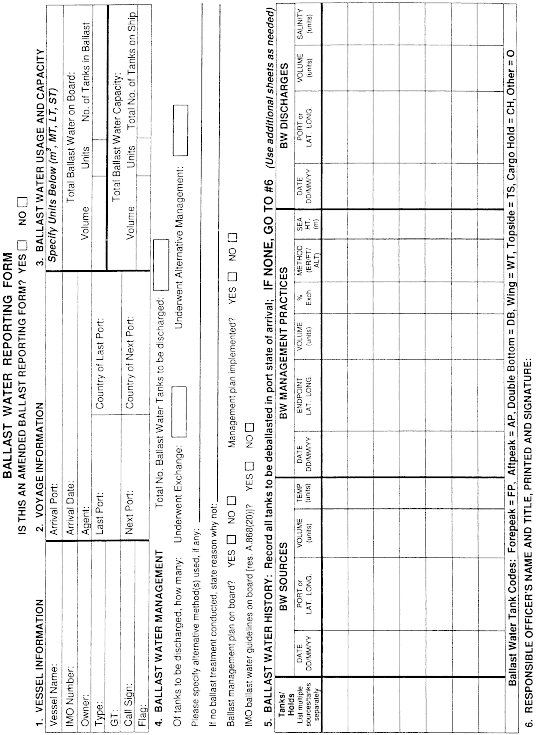 |
Code of Federal Regulations (Last Updated: November 8, 2024) |
 |
Title 33 - Navigation and Navigable Waters |
 |
Chapter I - Coast Guard, Department of Homeland Security |
 |
SubChapter O - Pollution |
 |
Part 151 - Vessels Carrying Oil, Noxious Liquid Substances, Garbage, Municipal or Commercial Waste, and Ballast Water |
 |
Subpart D - Ballast Water Management for Control of Nonindigenous Species in Waters of the United States |
Appendix to Subpart D of Part 151 - Ballast Water Reporting Form and Instructions for Ballast Water Reporting Form
-
Link to an amendment published at 77 FR 17311, March 23, 2012.



Where to send this form.
Vessels equipped with ballast water tanks bound for all ports or places within the waters of the United States after operating outside the EEZ (which includes the equivalent zone of Canada). Bound for You must submit your report as detailed below. The Great Lakes Fax the information at least 24 hours before the vessel arrives in Montreal, Quebec, to the USCG COTP Buffalo, Massena Detachment (315–769–5032) or to the Saint Lawrence Seaway Development Corporation (315–764–3250). In lieu of faxing, vessels that are not U.S. or Canadian flagged may complete the ballast water information section of the St. Lawrence Seaway “Pre-entry Information from Foreign Flagged Vessel Form”. Hudson River north of the George Washington Bridge Fax the information to the COTP New York at (718–354–4249) at least 24 hours before the vessel arrives at New York, New York.
*Note: Vessels entering COTP New York Zone which are not bound up the Hudson River north of George Washington Bridge should submit the form in accordance with the instructions in the following block.All other U.S. Ports Report before departing the port or place of departure if voyage is less than 24 hours, or at least 24 hours before arrival at the port or place of destination if the voyage exceeds 24 hours; and submit the required information to the National Ballast Information Clearinghouse (NBIC) by one of the following means:
Via the Internet at http://invasions.si.edu/NBIC/bwform.html; E-mail to NBIC@BALLASTREPORT.ORG ; Fax to 301–261–4319; or Mail the information to U.S. Coast Guard, c/o SERC. P.O. Box 28, Edgewater, MD 21037–0028.Vessels that have not operated outside the EEZ, which are equipped with ballast water tanks and are bound for all ports or places within the waters of the United States. Bound for You must submit your report as detailed below: All U.S. ports including the Great Lakes and Hudson River North of George Washington Bridge Report before departing the port or place of departure if voyage is less than 24 hours, or at least 24 hours before arrival at the port or place of destination if the voyage exceeds 24 hours; and submit the required information to the National Ballast Information Clearinghouse (NBIC) by one of the following means:
Via the Internet at http://invasions.si.edu/NBIC/bwform.html ; E-mail to NBIC@BALLASTREPORT.ORG; Fax to 301–261–4319; or Mail to U.S. Coast Guard, c/o SERC, P.O. Box 28, Edgewater, MD 21037–0028.If any information changes, send an amended form before the vessel departs the waters of the United States.
An agency may not conduct or sponsor, and a person is not required to respond to a collection of information unless it displays a valid OMB control number. The Coast Guard estimates that the average burden for this report is 35 minutes. You may submit any comments concerning the accuracy of this burden estimate or any suggestions for reducing the burden to: Commandant (CG–5224), U.S. Coast Guard, 2100 2nd St., SW. Stop 7126, Washington, DC 20593–7126, or Office of Management and Budget, Paperwork Reduction Project (1625–0069), Washington, DC 20503.
[USCG–1998–3423, 64 FR 26682, May 17, 1999, as amended at 66 FR 58391, Nov. 21, 2001; USCG–2002–13147, 69 FR 32870, June 14, 2004; USCG–2005–21531, 70 FR 36349, June 23, 2005; USCG–2008–0179, 73 FR 35014, June 19, 2008; USCG–2010–0351, 75 FR 36284, June 25, 2010; USCG–2011–0257, 76 FR 31837, June 2, 2011]